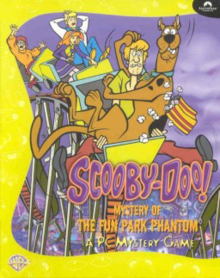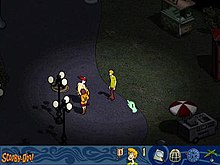Scooby-Doo! Mystery of the Fun Park Phantom
| Scooby Doo! Mystery of the Fun Park Phantom | |
|---|---|
 | |
| Developer(s) | Engineering Animation, Inc. |
| Publisher(s) | SouthPeak Interactive |
| Designer(s) | Rick Raymer |
| Engine | Proprietary |
| Platform(s) | Microsoft Windows |
| Release | December 28, 1999[1] |
| Genre(s) | Mystery/Puzzle |
| Mode(s) | Single player, multiplayer |
Scooby Doo! Mystery of the Fun Park Phantom is a 1999 mystery computer game developed by Engineering Animation, Inc. (EAI) and published by SouthPeak Interactive. The game was released for Microsoft Windows and was the first commercial Scooby-Doo game for the Windows operating system. It is intended for young children up to young teens.
Plot
[edit]The "Mystery Inc." gang find themselves stranded near an old farmhouse adjacent to an apparently abandoned amusement park. Approaching the farmhouse for help with the Mystery Machine (their van), the gang learns that the Gobs, the residents of the home, own the adjacent park, Gobs O' Fun. However, the park is being haunted by a phantom, scaring customers away. Without any customers, the Gobs are on the brink of bankruptcy, which will force them to sell the park. The gang agrees to help the Gobs find the culprit in exchange for help getting their van repaired.
Gameplay
[edit]The player or players can take on the role of any of the members of the Mystery Inc. gang, except for Scooby-Doo himself. Scooby instead helps each member of the gang from time to time. Players wander the park looking for clues that might pinpoint who the culprit is. The park is divided into nine sections, each with a different theme or main attraction, such as a Ferris wheel or a roller coaster. Each player may explore a different area or the same one. Some areas also contain neighbors and employees wandering in the deserted park, all of whom have motives for wanting the park closed. For example, the banker wants to build a shopping mall on the park site and the neighboring farmer wants to expand his farmland.
In addition to finding clues, the players can acquire trap pieces to help in finally trapping the suspect. There are two types of trap pieces: rare and common. There is only one instance of rare trap pieces in the park; common pieces are located in several places. Each trap requires one rare piece and two common pieces. Each trap is tailored for one of the nine areas. Also scattered about the park are a number of Scooby Snacks. Using these, the player can coax Scooby into helping them by baiting the trap, assigning a "Wheel of Chaos" spin for other players or use them to spin the "Wheel of Fun" for themselves.

A minimum of two of the Scooby gang must participate in attempting to solve the mystery. If a single player is playing, the computer can be assigned to play an opposing character. Turns proceed in a hotseat fashion, where players take turns moving their characters. Each player gets three "action points" per turn and may use them for a variety of actions. Each action costs a certain number of points. For example, picking up a clue or Scooby snack costs one point, moving from one area to another costs all three, or taking the manhole (a shortcut to another random area) takes two points. Just walking about an area, not picking up anything, is free.
The "Wheel of Chaos" is assigned from one player to an opposing player. It costs one Scooby Snack. Spinning the wheel, much like a fortune teller's wheel, results in an unfortunate event for the receiving player, such as losing a turn, Scooby snacks or trap pieces. The receiving player may block the wheel by sacrificing a Scooby Snack. Meanwhile, the "Wheel of Fun" is the opposite of the "Wheel of Chaos". Spinning it gives some kind of bonus to the spinning player. It costs one Scooby snack to spin the wheel. Whenever a player has any Scooby snacks, he is given the option of spinning the wheel at the beginning of their turn.
Once the player finds three clues, they know who the culprit is and must set up a trap for them. The player must have three pieces to one trap and be in the correct area for the trap. The player must also bribe Scooby to be the bait for the trap with Scooby snacks. The number of snacks the player uses affects how likely the trap will work. Three snacks will always result in a successful trapping; one has a high failure rate. A player may attempt to trap the phantom before getting three clues, but this will always result in a bungled trap attempt. Once the suspect is trapped, they are unmasked and a Full motion video (FMV) clip describes their motive. Since the culprit is different from game to game, it has high replay value.

Development
[edit]Designed by Rick Raymer, the game was originally slated to be called Scooby Doo: Mystery of the Gobs O' Fun Ghoul, but was changed by SouthPeak during development. SouthPeak, with an arrangement with Time-Warner, provided the team with videotapes of all 25 original half-hour episodes of Scooby-Doo to help them inject the game with an authentic feel.
After the initial video game design was complete, Raymer designed a full board game of the proposed computer game. An entire game board complete with game pieces representing the Scooby characters was produced by the art team. The development team brought in a group of the target demographic, children between the ages of seven and eleven, in order to test the game. Raymer acted as the gamemaster, performing the management of the game that would eventually be handled by the computer. One member of the development team paired up with each player and acted as a mentor, helping them know what could and couldn't be done each turn. The focus group loved the gameplay, the rewards and the general feel of the game. Only minor modifications were needed before executing the proposed design.
Though the characters for the game were derived from rendered 3D models, the game is 2D, using sprites derived from renderings of the 3D models. The models were also used to generate the game's FMV sequences. A major feature for the game was dynamic lighting for the park. With this feature enabled, the game evokes a mysterious, creepy tone authentic to the cartoon series.
The development team for Mystery of the Fun Park Phantom was almost identical to that for Clue, also by EAI, but published by Hasbro Interactive. The one addition to the team was Romalus Taylor, who programmed some AI and network code for the game. In addition, the game used the same in-house game engine for Mystery, EAGLE. It was heavily modified and enhanced over the year of development to support the new game.
The game includes extensive credits, however, some of the more notable contributors include:
- Harvey Lee, Executive Producer, SouthPeak Games
- Virginia McArthur, Producer, EAI Interactive
- Rick Raymer, Game Designer
- Chris Nash, Lead Programmer
- Joshua Jensen, Lead EAGLE Library Programmer
- Dink Thompson, 3D Modeling, Animator
- Mike Tirenin, Lead Artist
- Cynthia Meier, 2D/3D Artist
- Darren Eggett, Programmer
- Romalus Taylor, Programmer
- Michael Horn, Programmer
- Mike Reed, additional programming
- Greg Thoenen, additional programming
- Emily Modde, Level Designer
- Jason Wintersteller, Graphic Designer
- Cole Harris, Level Designer and Lead Tester
Most of the development team (McArthur, Raymer, Nash and Thompson) went on to work for Hasbro Interactive when EAI closed their game development studio after this game was completed.
Reception
[edit]| Publication | Score |
|---|---|
| IGN | 5.2/10[2] |
| Just Adventure | B+[3] |
In the United States, Mystery of the Fun Park Phantom appeared on PC Data's computer game sales rankings at #20 for June 2000, with an average retail price of $17.[4] After dropping out of the top 20 in July,[5] it rose to #18 for August.[6] According to PC Data, its domestic sales in August alone were 18,979 units, for revenues of $309,879.[7] The game was absent from the top 20 in September.[8] By 2006, Mystery of the Fun Park Phantom had sold between 100,000 and 290,000 units in the United States.[9]
References
[edit]- ^ "Scooby-Doo! Mystery of the Fun Park Phantom - IGN".
- ^ Blevins, Tal (January 10, 2000). "Scooby-Doo!: Mystery of the Fun Park Phantom - PC Review". IGN. Archived from the original on February 18, 2002. Retrieved August 17, 2010.
- ^ Sluganski, Randy. "Review: Scooby-Doo!: Mystery of the Fun Park Phantom". Just Adventure. Archived from the original on June 10, 2011.
- ^ Fudge, James (July 19, 2000). "Diablo II tops retail charts for June". Computer Games Magazine. Archived from the original on April 6, 2005.
- ^ Fudge, James (August 24, 2000). "PC Data Hits For July 2000". Computer Games Magazine. Archived from the original on April 6, 2005.
- ^ Walker, Trey (September 21, 2000). "Expansions Take Over Top Ten". GameSpot. Archived from the original on April 2, 2002.
- ^ Jamin, Sugih (October 13, 2006). "Computer Game Business" (PDF). University of Michigan. Archived (PDF) from the original on May 18, 2018.
- ^ Fudge, James (October 20, 2000). "Here come the expansion packs". Computer Games Strategy Plus. Archived from the original on May 15, 2005.
- ^ Edge Staff (August 25, 2006). "The Top 100 PC Games of the 21st Century". Edge. Archived from the original on October 17, 2012.


 French
French Deutsch
Deutsch